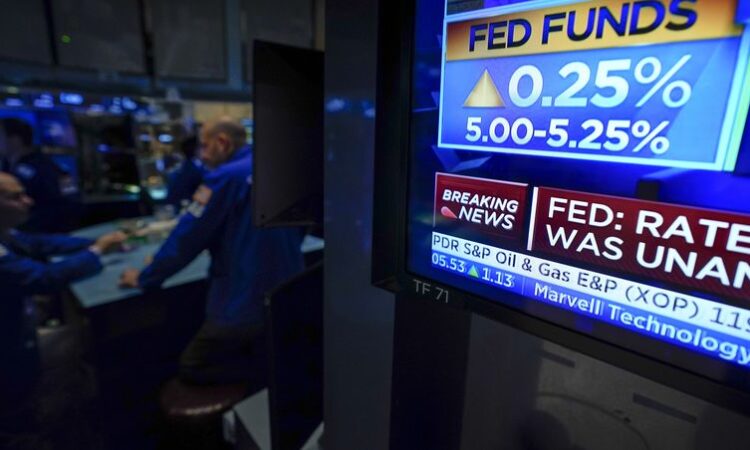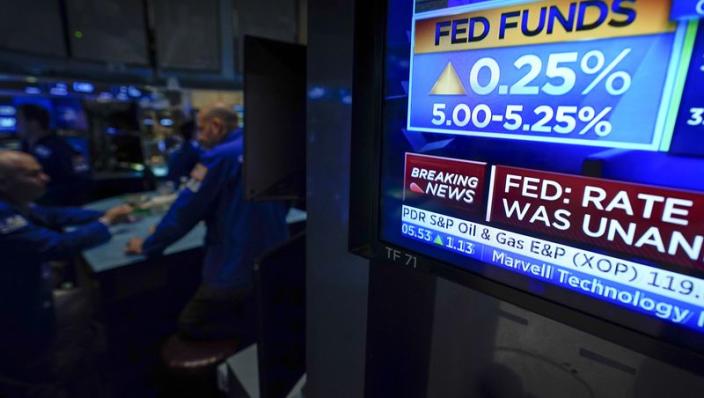

The Federal Reserve kept its streak alive on Wednesday, assessing a .25% hike on its benchmark interest rate, a move marking the 10th straight increase over the past year or so.
The decision by the Fed’s Open Market Committee brings the target range for the federal funds rate to 5%-5.25%. In its announcement of the rate adjustment, the Fed said it believes the U.S. banking system is “sound and resilient” but also noted tighter credit conditions for households and businesses “are likely to weigh on economic activity, hiring and inflation” in the coming months.
The rate increase comes in the wake of dissonant economic signals, including ongoing banking volatility that’s been exacerbated by increasing interest rates, marked just days ago when San Francisco-based First Republic Bank became the third major bank failure in the last two months, a fresh U.S. GDP report that found the overall U.S. economy in a slowdown, a still very hot U.S. jobs market that’s driving wage increases and consumer inflation that’s running well above the Fed’s target rate of 2%.
Related
The Federal Reserve’s 10 consecutive rate hikes have been its primary weapon in an ongoing battle against the elevated prices of consumer goods and services and represents the monetary body’s most aggressive series of increases in decades. The monetary body has now moved its federal funds rate some 500 basis points from the near zero mark it was at in March 2022.
The rate hikes aim to raise the cost of debt for businesses and consumers which should, theoretically, reduce the amount of spending and overall economic activity, a shift in dynamics that typically brings inflation rates down.
In a press conference Wednesday following the conclusion of the Fed’s two-day meeting, Chairman Jerome Powell shied away from declaring that the streak of rate hikes had now reached its peak, but language in the Fed’s press release has softened from previous increase announcements. But, Powell was a little more adamant about any potential rate reductions being a ways down the road.
“We have a goal of getting to 2% (inflation),” Powell said. “We think it’s going to take some time. We don’t think it will be a smooth process. We’re going to have to stay at this for a while.”
After hitting a high of 9.1% in June 2022, U.S. inflation marked nine straight months of declines in March with the overall rate coming in at 5.0% over the same time last year and down from 6.0% in February, according to the latest federal reporting.
While overall annual inflation dropped a full percentage point in March, core inflation, a metric that strips out volatile food and energy costs and a data point closely watched by the Federal Reserve, saw a 0.4% increase from February and at 5.6% is now outstripping headline inflation for the first time since early 2021.
Some regions of the U.S. saw inflation drop as low as 3.6% in March. But the Mountain West states, which include Utah, continue to hold down the unenviable top spot when it comes to price hikes on goods and services and saw a 6% annual rate in March.
When asked about the prospects for a coming recession, Powell sounded optimistic about the prospects of a “soft landing” for the overheated economy and noted that the Fed has been able to drive nine straight months of inflation declines without any appreciable impacts on the unemployment rate, which is hovering near 50-year lows. Recessionary periods are typically characterized by reduced consumer spending along with job losses and widespread economic slowing.
Powell also touched on the ongoing, partisan debate over a coming deadline for raising the ceiling on U.S. government debt and the possibility that a failure to reach an agreement could push the country into default circumstances. Powell said resolving the matter is entirely the responsibility of elected officials, but warned that the “Fed can’t protect the economy from the short and long-term effects of a failure to pay our bills on time.”
“From our standpoint, it’s essential that the debt ceiling be raised in a timely way so that the U.S. government can pay all of its bills when they’re due,” Powell said. “A failure to do that would be unprecedented. We’d be in uncharted territory and the consequences to the U.S. economy would be highly uncertain and could be quite adverse.”





